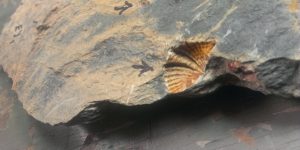On Monday, we were supposed to have a field trip to Beltsville, PA. The site is an outcrop of Devonian shale and siltstone–fine grained, mud-derived rocks that formed more than 350 million years ago. Eager for my field day, I got up at 6:30, dressing in cargo shorts, a sturdy button-down, emptying my backpack save for necessities for class, sliding my holstered swiss army knife onto a belt, and tying my hair back in a bandana. A few hours later, I grabbed out my raincoat and threw it on, shrugging my backpack on top. I set out for breakfast, walking through the rain on campus.
Unfortunately, our field trip was cancelled, a fact of which I was blissfully ignorant until I arrived in the paleontology lab, where we were to meet for our trip. While we were denied the field work that I was so looking forward to, we still had a wonderful time.

A few samples of fossiliferous rocks with a hand lens.
When I walked in, I noticed more than half a dozen trays, jammed full of fossiliferous shale. When we had all assembled, our professors, Pedro and Katherine Marenco, explained that the rainy conditions made the field site too hazardous. The trays were full of samples collected by students on previous trips to the same location. Our task? To fill up gallon bags of rock, two apiece, and catalogue the fossils in each rock.

A sample showing crinoid stalks and brachiopods.
We spent the next three hours and more identifying fossils, puzzling over cryptic patterns in rock, and trying to figure out whether the fossils were in the same shapes as the original organisms or inverted. Each rock held new samples–this one another fragment of a trilobite exoskeleton, another a new brachiopod (a shelled organism). The different organisms told us the environment must have been marine, a shallow sea. Reef-builders, such as earlier corals and bryozoans (a coral-like organism) plentiful in the Devonian. Some fossils were deformed, stretched out of shape, showing us that the rocks had been subjected to considerable strain after they formed. Many fossils were broken, not from the deformation or from rocks breaking, but from the original environment’s energy.

A well-preserved external mold of a brachiopod.

A fragment of a trilobite.
From the rocks we could build pictures of the oceans that must have existed near the shores of what would become North America. Flower-like crinoids would have sprouted from the floor, which would have been sprinkled with corals and bryozoans (coral-like organisms). Brachiopods and some bivalves (both shelled organisms) would have lain on the floor while trilobites swam and crawled around. With just a little thought, work, and a microscope, we can see so much. Here, in the rocks, we can see just a fragment of the mysteries that scientists are still working to unravel.
To quote Rachel Carson, as she wrote, in The Edge of the Sea, “to stand at the edge of the sea… is to have knowledge of things that are nearly as eternal as any earthly life can be.” So it is with these rocks, these traces of ancient life, some foreign to our eyes, some barely different in appearance than some of our modern organisms.

I love the melding of everyday life snapshots, science, and lyricism.
Hi Amelia:
When Nicole was pregnant with Eve, we scrambled over some amazing rocks in the Eastern Sierra, and I remember saying, “our child – whatever else she does in life – must become expert in geology, so that somebody someday can explain to us what the hell all these rocks are.” Hasn’t happened yet.
Anyway, we’re looking forward to adopting you and taking you out west. In the meantime, I will keep reading your blog.
Love, Warren
Amazing how much information can be garnered from rocks and fossils. I hope you get another opportunity to visit the site.